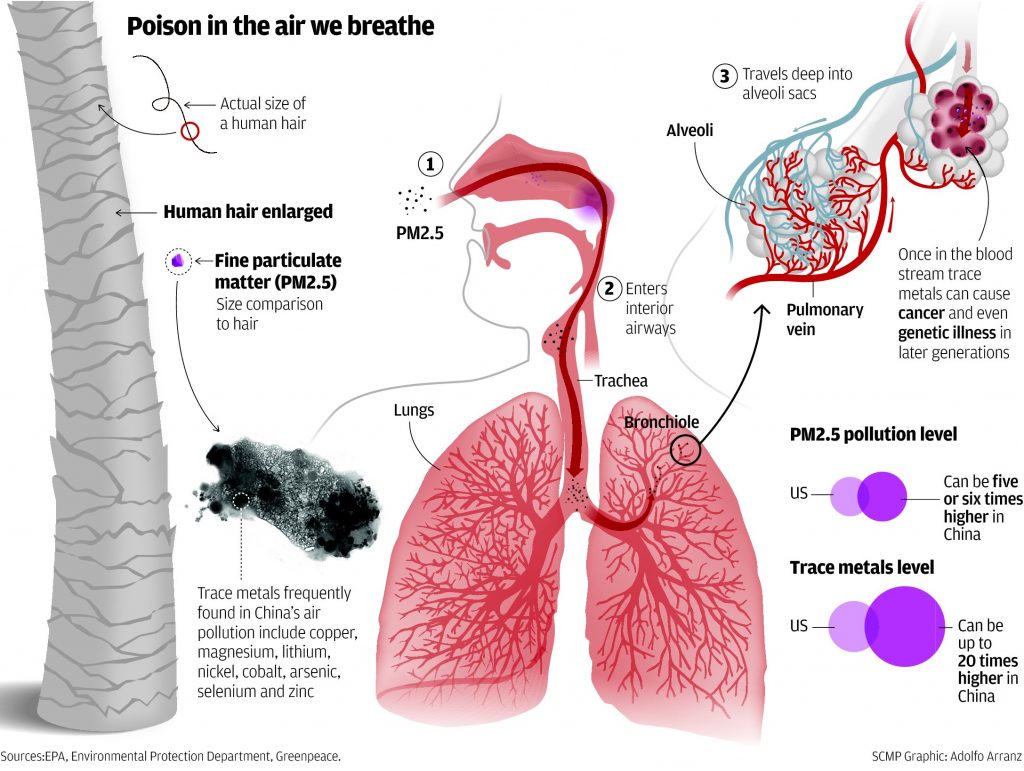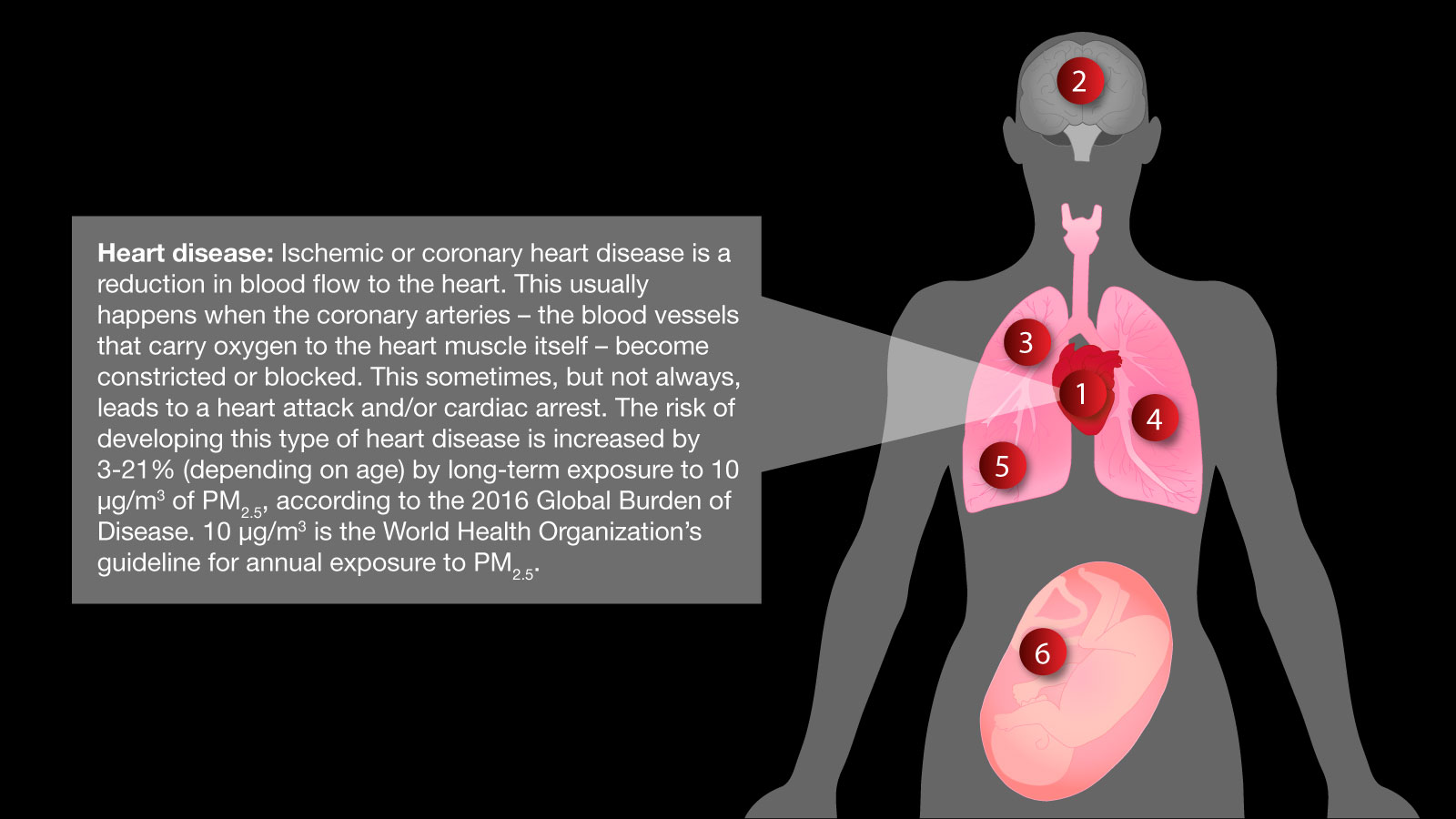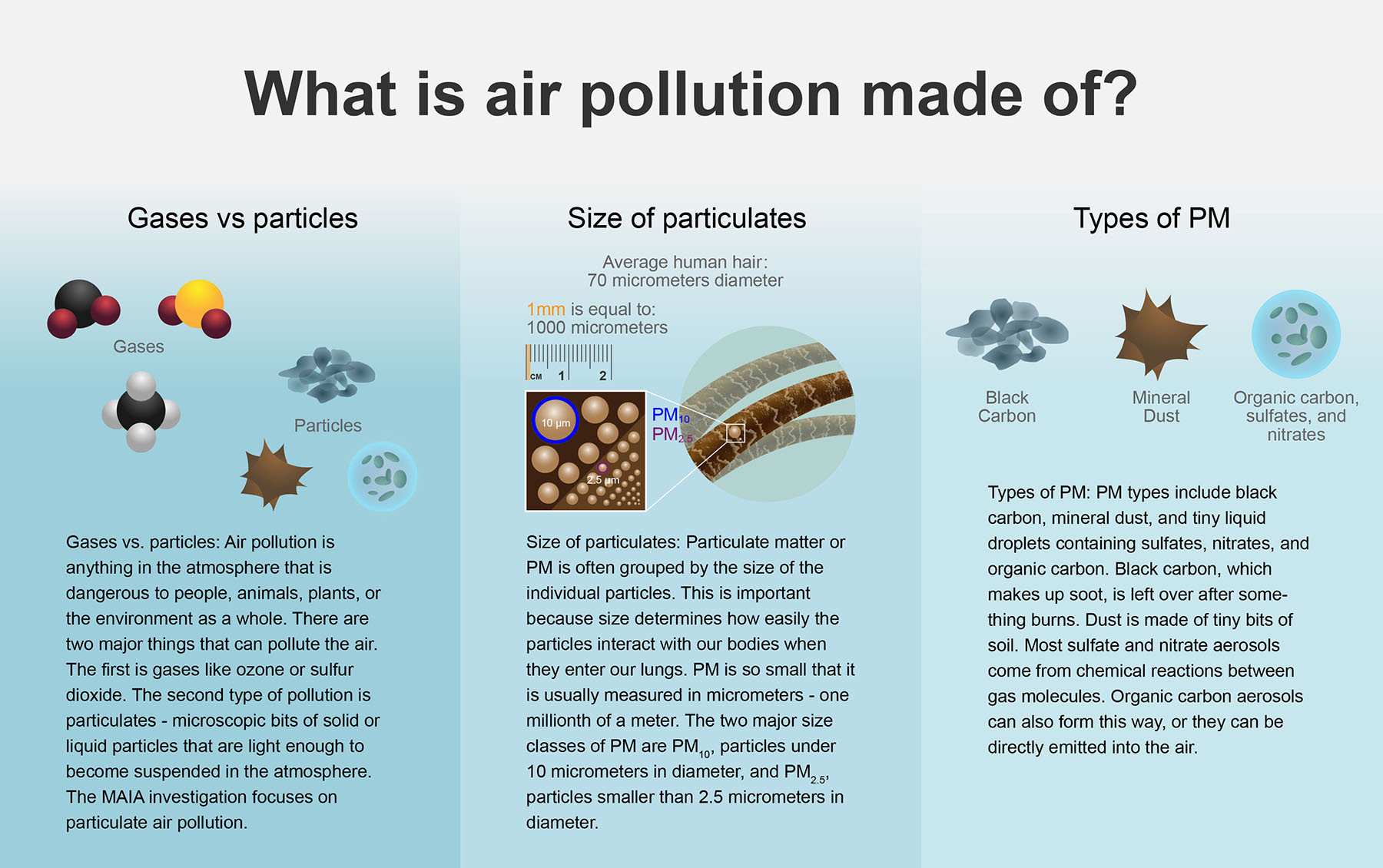Particles in the PM2.5 size range are able to travel deeply into the respiratory tract, reaching the lungs. Exposure to fine particles can cause short-term health effects such as eye, nose, throat and lung irritation, coughing, sneezing, runny nose and shortness of breath.
Particulate Matter 2.5
PM or Particulate matter is generally a mixture of soiled particles and water droplets present in the air. It includes aerosols, smoke, fumes, dust, ash, and pollen. Particle matter 2.5 is a pollutant particle which is so fine that it is not visible to the naked eye. The Diameter of this particle matter is 2.5 which is literally 30 times smaller than one hair strand. PM2.5 is tiny particles in the air that reduce visibility and cause the air to appear hazy when levels are elevated. Outdoor PM2.5 levels are most likely to be elevated on days with little or no wind or air mixing. The term fine particles, or particulate matter 2.5 (PM2.5), refers to tiny particles or droplets in the air that are two and one-half microns or less in width.
What sources cause PM 2.5 in your area?
PM 2.5 is mostly caused by humans than natural sources. Things like industrial emissions can also be important, as can the use of non-smokeless fuels for heating and other domestic sources of smoke such as bonfires. There are also caused by motor vehicles, power generations, wood stoves and agricultural burning. These are more profoundly the primary sources of air pollution. There are some secondary sources also causing the level of PM2.5 in the area such as the mixing of gases such as Sulphur dioxide (SO2) and nitrogen oxides (NOx: nitric oxide, NO plus nitrogen dioxide, NO2); these are called secondary particles.

Health Effects caused by PM 2.5
Inhaling of PM2.5 is extremely dangerous because it is more toxic and travels deeper into the body and its procurement is generally absorbed by the blood. This pollutant has also been an entity to be linked with causing Lung cancer and another kind of cancers. This pollutant causes airway irritability, respiratory issue and damage to lung tissues. People with asthma, cardiovascular or lung disease, as well as children and elderly people, are considered to be the most sensitive to the effects of fine particulate matter. There are many other serious health problems that are caused by inhaling of PM 2.5 such as different cardiovascular diseases, bronchitis and ultimately cause of premature deaths.
Ways to reduce exposure to PM2.5
There are measures to check the AQI i.e. the Air Quality Index of the area by the use of monitors to check the level of pollution that is being caused in the air around you. If the level of air quality is bad, there can be using of measures such as air purifiers that can help in balancing the level of pollution making the air cleaner and reducing the amounts of pollutants from the air.
Fine Particles (PM 2.5) Questions and Answers
Fine particulate matter (PM2.5) is an air pollutant that is a concern for people's health when levels in air are high. PM2.5 are tiny particles in the air that reduce visibility and cause the air to appear hazy when levels are elevated. Outdoor PM2.5 levels are most likely to be elevated on days with little or no wind or air mixing. The New York State Departments of Health (DOH) and Environmental Conservation (DEC) alert the public by issuing a PM2.5 Health Advisory when PM2.5 concentrations in outdoor air are expected to be unhealthy for sensitive groups.
What is Particulate Matter 2.5 (PM2.5)?
The term fine particles, or particulate matter 2.5 (PM2.5), refers to tiny particles or droplets in the air that are two and one half microns or less in width. Like inches, meters and miles, a micron is a unit of measurement for distance. There are about 25,000 microns in an inch. The widths of the larger particles in the PM2.5 size range would be about thirty times smaller than that of a human hair. The smaller particles are so small that several thousand of them could fit on the period at the end of this sentence.
How can PM2.5 affect my health?
Particles in the PM2.5 size range are able to travel deeply into the respiratory tract, reaching the lungs. Exposure to fine particles can cause short-term health effects such as eye, nose, throat and lung irritation, coughing, sneezing, runny nose and shortness of breath. Exposure to fine particles can affect heart and lung function worsening medical conditions such as heart disease and asthma, and increase the risk for heart attack. Scientific studies have linked increases in daily PM2.5 exposure with increased cardiovascular and respiratory hospital admissions, emergency department visits, and deaths. Studies also suggest that long-term exposure to fine particulate matter cause increased mortality from heart disease and may be associated with increased rates of chronic bronchitis, reduced lung function, and lung cancer. People with heart and breathing and problems, children, and older adults may be particularly sensitive to PM2.5.
Where does PM2.5 come from?
There are outdoor and indoor sources of fine particles. Outside, fine particles primarily come from car, truck, bus and off-road vehicle (e.g., construction equipment, snowmobile, locomotive) exhausts, other operations that involve the burning of fuels such as wood, heating oil or coal and natural sources such as forest and grass fires. Fine particles also form from the reaction of gases or droplets in the atmosphere from sources such as power plants. These chemical reactions can occur miles from the original source of the emissions. In New York State, some of the fine particles measured in the air are carried by wind from out-of-state sources. Because fine particles can be carried long distances from their source, events such as wildfires or volcanic eruptions can raise fine particle concentrations hundreds of miles from the event.
PM2.5 is also produced by common indoor activities. Some indoor sources of fine particles are tobacco smoke, cooking (e.g., frying, sautéing, and broiling), burning candles or oil lamps, and operating fireplaces and fuel-burning space heaters (e.g., kerosene heaters).
Is there an air quality standard for PM2.5 in outdoor air?
Yes, the United States Environmental Protection Agency (EPA) established National Ambient Air Quality Standards for PM2.5 in 1997 and revised them in 2006 and 2012. National Ambient Air Standards are established to be protective of public health. The short-term standard (24-hour or daily average) is 35 micrograms per cubic meter of air (µg/m3) and the long-term standard (annual average) is 12 µg/m3. A microgram is a unit of weight. There are a million micrograms in a gram, and a pound is equal to about 450 grams.
How will I know when PM2.5 levels are, or will be, elevated outside?
Outdoor air levels of fine particles increase during periods of stagnant air (very little wind and air mixing), when the particles are not carried away by wind, or when winds bring polluted air into the state from sources outside the state. In general, as the levels of PM2.5 in outdoor air increase, the air appears hazy and visibility is reduced. These conditions are similar in appearance to high humidity or fog. The New York State Department Environmental Conservation informs the public whenever fine particle concentrations in outdoor air are expected to be elevated. Every weekday morning the Department of Environmental Conservation will review weather conditions and data from their air monitoring stations to determine if, for that day or the following day, fine particle levels are expected to exceed levels considered unhealthy for sensitive groups. If it is likely that this level will be exceeded, the agency will contact the media so that a Particulate Matter Health Advisory can be carried on afternoon and evening broadcasts. The Department of Environmental Conservation also provides PM2.5 monitoring data and PM2.5 forecasts on its web site.
Are there ways to reduce my exposure to PM2.5?
When outdoor levels of PM2.5 are elevated, going indoors may reduce your exposure, although some outdoor particles will come indoors. If there are significant indoor sources of PM2.5, levels inside may not be lower than outside. Some ways to reduce exposure are to limit indoor and outdoor activities that produce fine particles (for example, burning candles indoors or open burning outdoors) and avoid strenuous activity in areas where fine particle levels are high.
How do scientists measure air pollution exposure?
Some devices can measure the composition of airborne particulate matter (PM) at ground level by collecting the particles on filters inside the monitor. The filters are collected, weighed, and analyzed in a laboratory to calculate the amounts of various particle types. But this analysis takes time, so the data are not available right away. Other instruments measure only the total amount of PM and provide the data right away. These two types of monitors on the ground are the most accurate way of measuring the amount and types of PM. However, because PM changes from place to place, you need a lot of ground monitors to measure PM over an entire city.
Instruments on space satellites can observe large areas of the Earth. A satellite in an orbit like that planned for MAIA can see a particular city every few days. MAIA will focus on a selected set of urban areas around the world. Each target will cover an area of more than 27,000 square miles (70,000 square kilometers, about the size of West Virginia).
The MAIA instrument will collect data that can be used to calculate the physical properties of PM, like their size, shape, and how they reflect or absorb sunlight. To determine the chemical composition of tiny particles of air pollution, the MAIA measurements will be combined with information from surface monitors and chemical transport models. See The MAIA Investigation for more.
How does air pollution affect your health?
Many scientific studies have shown that breathing air pollution, specifically airborne particulate matter (PM), increases your risk of several health problems. This is because larger particles can irritate the lungs and smaller particles can cause inflammation that affects other organs. Scientists have found that breathing PM causes heart disease, heart attacks, and strokes. Other scientific studies show that people who breathe more PM are more likely to develop lung cancer, lower respiratory infections, chronic obstructive pulmonary disease (COPD), and a number of problems during pregnancy and birth, such as low birth weight and premature delivery. Every year, new studies suggest that PM could increase the risk of more diseases.
Click on the numbers on the figure below to learn more about the different ways PM can affect your health.

Who is affected worldwide?
The Global Burden of Disease estimates that in 2019, 4.1 million people died sooner than expected as a result of being exposed to airborne PM. This type of air pollution is the greatest risk to peoples’ health that comes from the environmental around them (as opposed to behavioral or genetic risks like smoking or high blood pressure). It is among the top ten risk factors in all 195 countries studied by the Global Burden of Disease. However, in some countries, the risk is much greater. In China and India, for example, particulate air pollution is responsible for 13.4% and 10.4% of all deaths, respectively—around 1 million premature deaths annually in each country. Most of deaths caused by particulate air pollution around the world were attributed to heart attacks (32.6%) and chronic obstructive pulmonary disease (COPD)(17.0%).
This map shows the percent of all deaths in each country linked to breathing PM air pollution, according to the Global Burden of Disease. The background shows a map of average PM amounts from 2001-2010 calculated from NASA satellite data and other sources. Search for or click on a country for more details.
How do scientists study air pollution and health?
The study of the causes, distribution, and frequency of disease is called epidemiology. Epidemiologists gather evidence to connect diseases to risk factors. This branch of science has existed since the nineteenth century, but epidemiologists first started studying air pollution in the 1950s. One well-known event in the field is the Great Smog of London in 1952, which lasted four days and was so thick that at least one theater cancelled an opera performance because customers couldn’t see the stage from their seats, even indoors. The UK Ministry of Health estimated two years later that between 3,500 and 4,000 people died because of the smog, most of whom had pre-existing lung or heart disease. Several laws were passed in the following years to try to reduce air pollution.
One challenge faced by epidemiologists is confounding factors. These are factors other than the risk being studied that could also cause a study participant to contract the disease. For example, in a study examining the connection between air pollution and lung cancer, epidemiologists would need to account for any participants who also smoke.
There are two basic ways that scientists are studying the impacts of air pollution and health: time-series studies and cohort studies.
In a time-series study, epidemiologists analyze records of deaths and hospitalizations in a particular city or urban area. They investigate the relationship between these records and the short-term concentrations of air pollution. These studies are effective since epidemiologists only need to account for confounding factors that change on a daily basis, such as the weather and the day of the week.
Cohort studies examine the impacts of long-term (one-year or more) exposure to air pollution on health. Epidemiologists follow a large group of people (tens of thousands to millions) for several years, tracking their health. After personal confounding factors like family history and smoking are taken into account, the epidemiologists can calculate the impact of air pollution on people’s chance of getting various diseases. Typically, cohort studies show that long-term exposure to air pollution is much more dangerous than the short-term effects demonstrated in time-series studies.


No comments:
Post a Comment